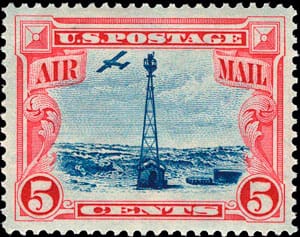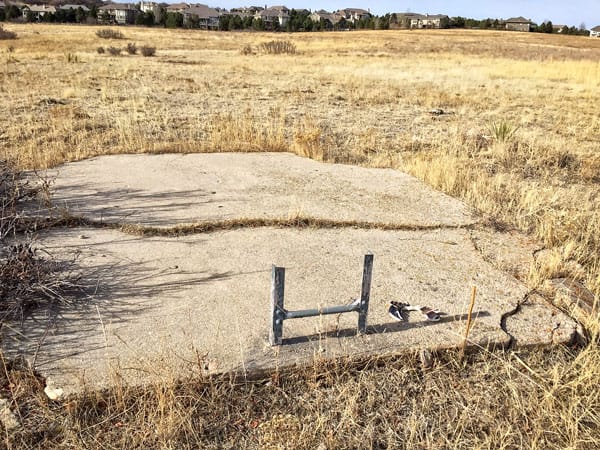Wildcat Mountain highway in the sky

A copy of the U.S. airmail stamp, issued in 1928, commemorating airmail services guided by beacon (the one on the Castle Pines summit looked just like this).

Number 9 beacon footing with ladder remnants and porcelain insulator chards in November, 2016.
Article and photos by Joe Gschwendtner
Sixteen years after the Wright brothers’ epic 1903 first flight, night-time navigational aids (other than bonfires) were non-existent. With the demand for airmail growing ever stronger, night flight was inevitable. Two pilots, Don Bruner and Jack Knight, figured it out. Artificial beacons on high terrain could be used to create a sky-highway for pilots who flew regular mail routes.
Beginning in 1923, the U.S. Post Office embarked on building just such a transcontinental system. No small undertaking, when completed in 1933, 18,000 miles of airways had over 1,500 lights. Some were revolving beacons mounted on top of 51-foot towers with 40-mile visibility in good weather. Others were merely blinkers to warn of dangerous, high terrain.
Our Wildcat Mountains were directly under the Pueblo-to-Cheyenne mail route; thus the airway paralleled I-25 very closely. From Greenland to Castle Pines there were three beacons and three blinkers. Number 9 Beacon on the route was positioned at 6,535 feet elevation and several hundred yards east of El Diente Court in Castle Pines Village. Number 8 was on the rock now known as “Castle Rock,” which when installed was a million-candlepower light. The Castle Rock newspaper saw it as having “inestimable value” and believed that it would “draw quite a lot of attention to Castle Rock from those passing this way.”
Further south, three blinkers were installed, one each on Raspberry and Larkspur Buttes, and one on Spruce Mountain. Number 7 Beacon was placed on Hunt Mountain, the high ridge north of Larkspur and east of the railroad tracks. When completed, maintaining this light cluster proved to be a full-time job. Thus, it was Matt Dormer, a horseman, raised in a log ranch house at the base of Hunt Mountain, who was selected to be the caretaker.
Since the blinkers operated on acetylene gas, Dormer had to haul the heavy containers up and down the buttes tied to skids pulled by a horse team. The beacon often proved equally challenging to maintain, as it was operated by a gasoline engine controlled by an unreliable time clock. When the clock failed and had to be taken for repair, the engine required hand-starting every day until the repair was finished. A not uncommon occurrence, Dormer and daughters Margaret and Alice took turns riding horseback for the daily eight-hour roundtrip to the beacon while the clock was out of commission.
By 1934, the Low Frequency Radio Range System navigation began to replace the visual guidance, and Dormer was soon dropped from the government payroll. He and wife Bess “bought the Kinner place” and raised vegetables. Not enough, Bess learned to weld, and Matt worked downtown at Kroll’s Grocery to provide steady income. One can only wonder how Dormer viewed his place in aviation history.